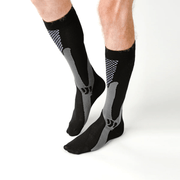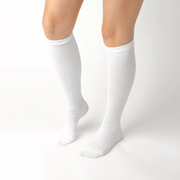Compression socks are specialized hosiery designed to promote better blood flow in the legs and feet. They are commonly recommended for people who experience leg pain, swelling, or conditions like varicose veins and chronic venous insufficiency. Understanding what compression socks do and how they work can help you decide if they are right for your needs.
What Do Compression Socks Do?
Compression socks apply gentle, graduated pressure to the legs, which helps improve blood flow and prevent blood from pooling in the veins. This is especially beneficial for those prone to blood clots or deep vein thrombosis (DVT), a serious condition where blood clots form in deep veins, typically in the legs [1]. By enhancing circulation, compression socks can reduce swelling, sore muscles, and the appearance of varicose veins [2].
Types of Compression Socks and Stockings
There are several types of compression garments, including compression socks, compression stockings, and compression sleeves. Medical grade compression socks and graduated compression stockings are specially designed for therapeutic use and come in different grades of compression, measured in millimeters of mercury (mmHg). The right compression grade depends on your condition and needs, with some recommended for preventing pulmonary embolism and others for general leg support [3].
Anti-embolism stockings, also known as TED stockings or anti embolism stockings, are often used in hospitals to prevent blood clots in bedridden patients. These medical grade compression stockings work by applying consistent pressure to improve oxygen rich blood flow, reducing the risk of pulmonary embolism [4].
When to Wear Compression Socks
Wearing compression socks is advised for those who suffer from chronic venous insufficiency, leg veins problems, or who need to prevent blood clots during long periods of immobility, such as during flights or post-surgery [5]. Athletes may also use compression socks to support calf muscles, reduce soreness, and enhance recovery [6].
It's important to wear compression stockings or socks correctly—wear them in the morning when swelling is minimal, and remove them before going to bed [7]. Choosing the right compression garments, including the right grade compression and fit, is essential to ensure effectiveness and comfort [10].
Benefits of Compression Socks
The benefits of compression socks are numerous:
-
They improve blood flow, which can reduce leg pain and swelling.
-
They prevent blood clots and reduce the risk of deep vein thrombosis.
-
They help manage varicose veins and chronic venous insufficiency.
-
They support calf muscles, reducing fatigue and soreness.
-
They contribute to overall vascular health by aiding blood vessels [8].
Medical grade compression socks work by applying graduated pressure, tighter at the ankle and gradually lessening up the leg, promoting venous return to the heart. This graduated compression is key to their effectiveness [9]. Compression therapy can be especially beneficial in managing venous insufficiency and preventing complications related to blood flow problems.
Additional Considerations
When purchasing compression socks, look for those designed for your specific needs, whether for athletic use, medical grade compression, or everyday wear. Proper sizing and usage are critical; wearing the right compression socks or stockings can prevent complications and maximize benefits [10]. Avoid wearing tight stockings or compression garments that do not fit properly, as they may cause discomfort or worsen circulation.
While compression therapy is generally safe, always consult your healthcare provider before starting use, especially if you have underlying conditions or require medical grade compression [11].
Conclusion
Compression socks offer a practical solution for improving leg health, reducing swelling, and preventing serious complications such as blood clots and pulmonary embolism. They are effective for both medical and athletic use, and choosing the right compression garments can make a significant difference in comfort and vascular health.
References
-
National Heart, Lung, and Blood Institute. (2023). Deep Vein Thrombosis. Retrieved from https://www.nhlbi.nih.gov/health-topics/deep-vein-thrombosis
-
Mayo Clinic. (2022). Varicose Veins. Retrieved from https://www.mayoclinic.org/diseases-conditions/varicose-veins
-
American College of Phlebology. (2023). Compression Stockings. Retrieved from https://www.phlebology.org/compression-stockings
-
American Society of Hematology. (2021). Prevention of Venous Thromboembolism. Retrieved from https://www.hematology.org/education/clinicians/guidelines-and-quality-care/venous-thromboembolism
-
Cleveland Clinic. (2023). When to Wear Compression Stockings. Retrieved from https://my.clevelandclinic.org/health/treatments/16762-compression-stockings
-
Journal of Sports Medicine. (2020). Effects of Compression Socks on Athletic Performance.
-
Vascular Health Review. (2021). Guidelines for Wearing Compression Garments.
-
National Institute for Health and Care Excellence (NICE). (2023). Compression Therapy for Chronic Venous Disease.
-
Vascular Medicine Journal. (2022). Graduated Compression Therapy: Mechanisms and Outcomes.
-
British Journal of Nursing. (2021). Proper Use and Sizing of Compression Stockings.
 Active Compression
Active Compression
 Plain Compression Socks
Plain Compression Socks

